p.326
p.332
p.338
p.342
p.347
p.352
p.357
p.362
p.368
Photovoltaic Effects of Bismuth Ferrite and Nd-Doped Barium Titanate Thin Films Prepared by Sol-Gel Method
Abstract:
Ferroelectric is a great potential material as new solar cells, light driver and optical sensor because of its anomalous photovoltaic effect. Bismuth ferrite and Nd-doped barium titanate thin films were prepared via sol–gel spin-coating method in the present study. The experimental results show that substitution of Nd3+ ions for Ba2+ on A sites leads to the decrease of band gap, and the short circuit photocurrent density, open circuit photovoltage and power conversion efficiency of Nd-doped barium titanate thin films begin to increase and reach the maximum and then decrease as Nd content increases. It has been found that the band gap of bismuth ferrite thin films annealed at 550–650oC was between 2.306 eV and 2.453 eV. The short circuit photocurrent density decreased with the rise of annealing temperature, and the open circuit photovoltage and the power conversion efficiency of bismuth ferrite thin films annealed at 550oC were higher than the thin films annealed at higher temperature.
Info:
Periodical:
Pages:
347-351
Citation:
Online since:
April 2014
Authors:
Keywords:
Price:
Сopyright:
© 2014 Trans Tech Publications Ltd. All Rights Reserved
Share:
Citation:


